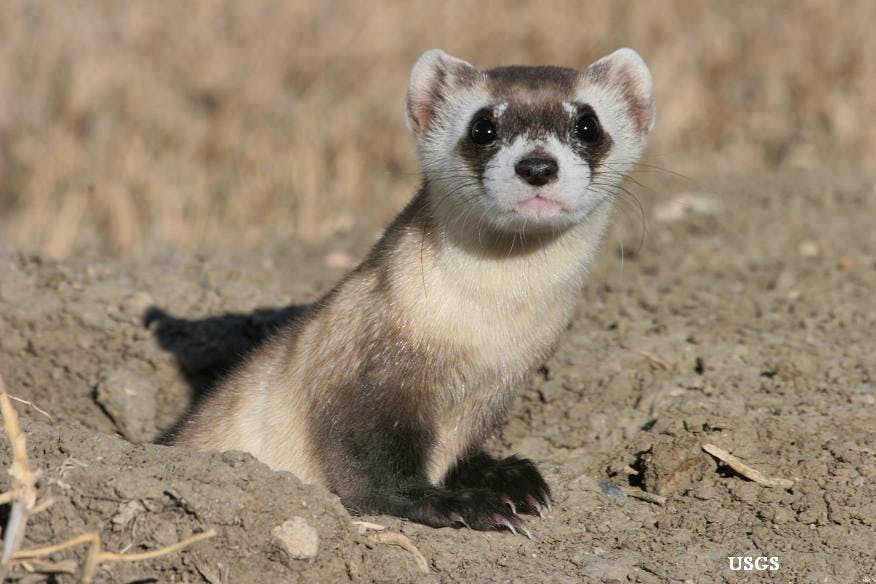Jonathan Proctor, Rockies and Plains Representative
What’s the Deal with Ferrets?

Black-footed ferrets rely on large prairie dog colonies for food and shelter.
Black-footed ferrets are small predators that live only in large prairie dog colonies across the central and western grasslands of North America. They live in prairie dog burrows and prairie dogs make up more than 90 percent of their diet. They are one of only three ferret species in the world and the only one native to North America. They are often confused with domestic ferrets, which appear similar but are actually a different species originally from Europe.
Black-footed ferrets numbered in the tens of thousands before the 1800s, but were brought to the brink of extinction due to widespread human destruction of their prairie-dog-colony habitat and the arrival of exotic diseases including sylvatic plague in the 1900s. Back then, before the protections of the Endangered Species Act, the U.S. government viewed prairie dogs as a pest, and actually paid for the widespread poisoning of prairie dog colonies that brought the black-footed ferret to the brink of extinction.
The ESA Saves the Day
The Endangered Species Act (ESA) is our nation’s landmark wildlife conservation law. It was signed into law in 1973. So few black-footed ferrets remained at that time that they were one of the original species protected under the new law. But they were already too far gone in the wild, and when the last known black-footed ferret died in captivity in 1979 they were declared extinct.
Then, on September 26, 1981, a ranch dog named Shep caught a black-footed ferret in Meeteetse, Wyoming, leading to the discovery of a single remaining population. This time, the protections of the ESA led to a flurry of activity to save this species from a “second” extinction. Dedicated conservationists from federal, state and private agencies jumped on the opportunity to help the species survive and recover.
This last population was mapped, studied and monitored. But before long, disease struck. The few remainders were captured. By 1986, only 18 black-footed ferrets were alive, all in captivity. Thus began a 25-year-and-counting captive breeding program. A federal recovery plan was drafted in 1988, which guided plans to increase the captive population and then restore the species to the wild.

Defenders’ Jonathan Proctor releases a black-footed ferret in Conata Basin, South Dakota (Credit: Steve Forrest)
Since the first reintroduction into Wyoming’s Shirley Basin in 1991, black-footed ferrets have been reintroduced in 19 locations in Wyoming, South Dakota, Montana, Colorado, Utah, Arizona, Kansas, New Mexico, the Mexican state of Chihuahua and the Canadian province of Saskatchewan. Today, the U.S. Fish and Wildlife Service estimates that about 750 ferrets now live in 17 of these locations (half of the population goal outlined in the 1988 Black-footed Ferret Recovery Plan) and another 350 or so in captive breeding facilities. Four locations have surpassed the required minimum of 30 breeding adults. At least six more must reach this goal. For a species once at the very brink of extinction, an amazingly full recovery of this species is within our grasp.
It is difficult to speculate how much of this work would have been done without the ESA, but it is likely that the black-footed ferret would be extinct today without the level of commitment and funding that resulted from this law. Federal oversight under the authority of the ESA has led to the collaboration of dozens of federal, state and tribal agencies, in cooperation with private landowners, conservation groups including Defenders of Wildlife, and the North American zoo community. A national black-footed ferret conservation center has produced thousands of black-footed ferrets for reintroduction.
As an official member of the U.S. Fish and Wildlife Service black-footed ferret recovery implementation team, Defenders is assisting the effort to reintroduce black-footed ferrets and protect them in their native habitat. Because prairie dogs are so important to black-footed ferrets, we are working to restore prairie dogs to new sites such as Thunder Basin National Grassland in Wyoming and prevent the destruction of prairie dog colonies in existing black-footed ferret areas like Conata Basin in South Dakota.
We’re also helping a group of ranchers in Kansas who are fighting to save prairie dogs and their newly reintroduced ferret population from a century-old state law requiring the death of all prairie dogs. And we’re working on solutions to help reduce conflict with neighbors of these sites who do not want prairie dog colonies expanding onto their properties. By installing portable electric fences to keep cattle out of 100 foot “buffer zones” along property boundaries, the grass can grow tall enough to discourage prairie dogs from colonizing there — prairie dogs avoid tall grass due to threats from predators.
Looking Forward
Though we have a long way to go to full black-footed ferret recovery, by nearly all measurements the ferret’s reintroduction to the wild has been a stunning accomplishment. Our challenge now is to restore more large colonies of prairie dogs and reintroduce more ferrets so that we can finish the job of recovering one of the most endangered mammals on the continent. Ferrets have been given a second chance. Now it’s our job to make sure their rediscovery was not in vain.
Want to see a black-footed ferret in action? Check out this neat video of one in the wild.



